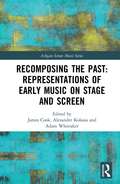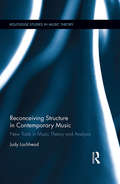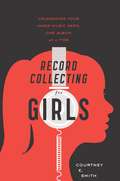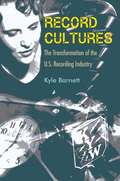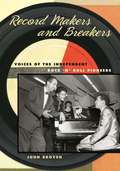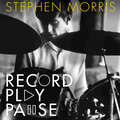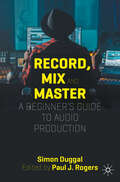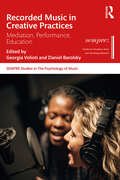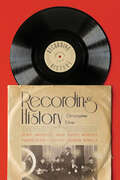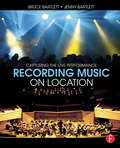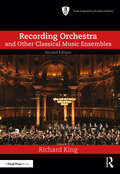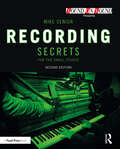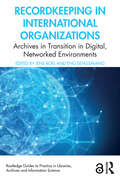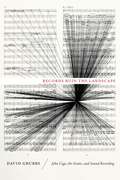- Table View
- List View
Reclaiming Late-Romantic Music
by Peter FranklinWhy are some of the most beloved and frequently performed works of the late-romantic period--Mahler, Delius, Debussy, Sibelius, Puccini--regarded by many critics as perhaps not quite of the first rank? Why has modernist discourse continued to brand these works as overly sentimental and emotionally self-indulgent? Peter Franklin takes a close and even-handed look at how and why late-romantic symphonies and operas steered a complex course between modernism and mass culture in the period leading up to the Second World War. The style's continuing popularity and its domination of the film music idiom (via work by composers such as Max Steiner, Erich Wolfgang Korngold, and their successors) bring late-romantic music to thousands of listeners who have never set foot in a concert hall. Reclaiming Late-Romantic Music sheds new light on these often unfairly disparaged works and explores the historical dimension of their continuing role in the contemporary sound world.
Reclaiming Venus: The Many Lives of Alvenia Bridges
by Alvenia Bridges Dr Maya Angela Smith"Reclaiming Venus: The Many Lives of Alvenia Bridges" chronicles the remarkable journey of Alvenia Bridges from segregated Kansas to the heights of fashion and rock 'n' roll, breaking barriers and rubbing shoulders with legends. It is a powerful testament to resilience and the pursuit of dreams against all odds. "Reclaiming Venus: The Many Lives of Alvenia Bridges" chronicles the remarkable journey of Alvenia Bridges from segregated Kansas to the heights of fashion and rock 'n' roll, breaking barriers and rubbing shoulders with legends. It is a powerful testament to resilience and the pursuit of dreams against all odds. Growing up in the 1950s in segregated Kansas, Alvenia Bridges dreamed of leaving home and seeing the world. Despite her destructive home life and the racially oppressive environment of her childhood, Alvenia graduated high school, left for L.A., and successfully navigated the predominantly white and male-run worlds of fashion and 70s and 80s Rock and Roll. From a chance encounter with race car driver John Von Neumann that jump-started her modeling career in Europe to her years working for famous musicians, Alvenia's unflappable resolve left her impressively mobile in the face of societal constraints. Alvenia had much to share with the world as she crossed paths and worked with a wide variety of people in the music and fashion industries, from long-term working relationships with Bill Graham, Roberta Flack, and the Rolling Stones, to momentary yet extraordinary encounters with Jimi Hendrix, John Lennon, Prince, and Tina Turner, to personal and professional interactions with Jerry Hall, Antonio Lopez, and Francesco Scavullo. Alvenia's remarkable life forged a path through glass ceilings and blocked doors that reads like a work of fiction.
Recommender Systems for Medicine and Music (Studies in Computational Intelligence #946)
by Zbigniew W. Ras Alicja Wieczorkowska Shusaku TsumotoMusic recommendation systems are becoming more and more popular. The increasing amount of personal data left by users on social media contributes to more accurate inference of the user’s musical preferences and the same to quality of personalized systems. Health recommendation systems have become indispensable tools in decision making processes in the healthcare sector. Their main objective is to ensure the availability of valuable information at the right time by ensuring information quality, trustworthiness, authentication, and privacy concerns. Medical doctors deal with various kinds of diseases in which the music therapy helps to improve symptoms. Listening to music may improve heart rate, respiratory rate, and blood pressure in people with heart disease. Sound healing therapy uses aspects of music to improve physical and emotional health and well-being. The book presents a variety of approaches useful to create recommendation systems in healthcare, music, and in music therapy.
Recomposing the Past: Representations Of Early Music On Stage And Screen (Ashgate Screen Music Series)
by James Cook Alexander Kolassa Adam WhittakerRecomposing the Past is a book concerned with the complex but important ways in which we engage with the past in modern times. Contributors examine how media on stage and screen uses music, and in particular early music, to evoke and recompose a distant past. Culture, popular and otherwise, is awash with a stylise - sometimes contradictory - musical history. And yet for all its complexities, these representations of the past through music are integral to how our contemporary and collective imaginations understand history. More importantly, they offer a valuable insight into how we understand our musical present. Such representative strategies, the book argues, cross generic boundaries, and as such it brings together a range of multimedia discussion on the subjects of film (Lord of the Rings, Dangerous Liasions), television (Game of Thrones, The Borgias), videogame (Dragon Warrior, Gauntlet), and opera (Written on Skin, Taverner, English ‘dramatick opera’). This collection constitutes a significant, and interdisciplinary, contribution to a growing literature which is unpacking our ongoing creative dialogue with the past. Divided into three complementary sections, grouped not by genre or media but by theme, it considers: ‘Authenticity, Appropriateness, and Recomposing the Past’, ‘Music, Space, and Place: Geography as History’, and ‘Presentness and the Past: Dialogues between Old and New’. Like the musical collage that is our shared multimedia historical soundscape, it is hoped that this collection is, in its eclecticism, more than the sum of its parts.
Reconceiving Structure in Contemporary Music: New Tools in Music Theory and Analysis (Routledge Studies in Music Theory)
by Judy LochheadThis book studies recent music in the western classical tradition, offering a critique of current analytical/theoretical approaches and proposing alternatives. The critique addresses the present fringe status of recent music sometimes described as crossover, postmodern, post-classical, post-minimalist, etc. and demonstrates that existing descriptive languages and analytical approaches do not provide adequate tools to address this music in positive and productive terms. Existing tools and concepts were developed primarily in the mid-20th century in tandem with the high modernist compositional aesthetic, and they have changed little since then. The aesthetics of music composition, on the other hand, have been in constant transformation. Lochhead proposes new ways to conceive musical works, their structurings of musical experience and time, and the procedures and goals of analytic close reading. These tools define investigative procedures that engage the multiple perspectives of composers, performers, and listeners, and that generate conceptual modes unique to each work. In action, they rebuild a conceptual, methodological, and experiential place for recent music. These new approaches are demonstrated in analyses of four pieces: Kaija Saariaho’s Lonh (1996), Sofia Gubaidulina’s Second String Quartet (1987), Stacy Garrop’s String Quartet no.2, Demons and Angels (2004-05), and Anna Clyne’s "Choke" (2004). This book defies the prediction of classical music’s death, and will be of interest to scholars and musicians of classical music, and those interested in music theory, musicology, and aural culture.
Reconfiguring Myth and Narrative in Contemporary Opera
by Yayoi Uno EverettYayoi Uno Everett focuses on four operas that helped shape the careers of the composers Osvaldo Golijov, Kaija Saariaho, John Adams, and Tan Dun, which represent a unique encounter of music and production through what Everett calls "multimodal narrative." Aspects of production design, the mechanics of stagecraft, and their interaction with music and sung texts contribute significantly to the semiotics of operatic storytelling. Everett's study draws on Northrop Frye's theories of myth, Lacanian psychoanalysis via Slavoj i ek, Linda and Michael Hutcheon's notion of production, and musical semiotics found in Robert Hatten's concept of troping in order to provide original interpretive models for conceptualizing new operatic narratives.
Record Collecting For Girls: Unleashing Your Inner Music Nerd, One Album at a Time
by Courtney E. Smith“Record Collecting for Girls is an invitation for all of you stereophiles (who happen to be female), to make your own top-five lists, and then, armed and ready with the book’s fun facts, to argue their merits to the ever-present boys’ club of music snobs in your life.” —Sarahbeth Purcell, author of Love Is the Drug and This Is Not a Love SongYou never leave home without your iPod. You’re always on the lookout for new bands, and you have strong opinions when it comes to music debates, like Beatles vs. Stones. For years, you’ve listened to guys talk about all things music, but the female perspective has been missing. Until now. Drawing on her personal life as a music enthusiast, as well as her experience working at MTV and in radio, Courtney E. Smith explores what music can tell women about themselves—and the men in their lives. She takes on a range of topics, from the romantic soundtracks of Romeo and Juliet to the evolution of girl bands. She shares stories from her own life that shed light on the phenomenon of guilty pleasures and the incredible power of an Our Song. Along the way, she evaluates the essential role that music plays as we navigate life’s glorious victories and its soul-crushing defeats. Finally, here is a voice that speaks to women—because girls get their hearts broken and make mix tapes about it, too. “Courtney Smith has smarts and sass in spades. Her insights are as hilarious as they are thoughtful, and when you finish reading this book, you’ll feel like you just got home from a perfect night out with your best friend. And you’ll want to listen to Prince. At full volume.” —Megan Jasper, Executive Vice President, Sub Pop Records
Record Cultures: The Transformation of the U.S. Recording Industry
by Kyle BarnettRecord Cultures tells the story of how early U.S. commercial recording companies captured American musical culture in a key period in both music and media history. Amid dramatic technological and cultural changes of the 1920s and 1930s, small recording companies in the United States began to explore the genres that would later be known as jazz, blues, and country. Smaller record labels, many based in rural or out of the way Midwestern and Southern towns, were willing to take risks on the country’s regional vernacular music as a way to compete with more established recording labels. Recording companies’ relationship with radio grew closer as both industries were on the rise, propelled by new technologies. Radio, which had become immensely popular, began broadcasting more recorded music in place of live performances, and this created profitable symbiosis. With the advent of the talkies, the film industry completed the media trifecta. The novelty of recorded sound was replacing film accompanists, and the popularity of movie musicals solidified film’s connections with the radio and recording industries. By the early 1930s, the recording industry had gone from being part of the largely autonomous phonograph industry to being major media industry of its own, albeit deeply tied to—and, in some cases, owned by—the radio and film industries. The triangular relationships between these media industries marked the first major entertainment and media conglomerates in U.S. history. Through an interdisciplinary and intermedial approach to recording industry history, Record Cultures creates new connections between different strands of media research. It will be of interest to scholars of popular music, media studies, sound studies, American culture, and the history of film, television, and radio.
Record Label Marketing, 2nd ed.
by Paul Allen Tom Hutchison Amy MacyRecord Label Marketing offers a comprehensive look at the inner workings of record labels, showing how the record labels connect commercial music with consumers. In the current climate of selling music through both traditional channels and new media, authors Tom Hutchison, Paul Allen and Amy Macy carefully explain the components of the contemporary record label's marketing plan and how it is executed. This new edition is clearly illustrated throughout with figures, tables, graphs, and glossaries, and includes a valuable overview of the music industry.<P> Record Label Marketing has become essential reading for current and aspiring professionals, and for music business students everywhere. <P> Record Label Marketing.<P> * Gives you an exclusive and complete look at SoundScan and how it is used as a marketing tool<P> * Presents essential information on uses of new media, label publicity, advertising, retail distribution, and marketing research by record labels<P> * Offers insight into how successful labels use videos, promotional touring, and special products to build revenue<P> * Includes important specialized marketing strategies using the tools of grassroots promotion and international opportunities<P> * Reveals how labels are managing within their transitional digital industry<P> * Looks to the future of the music business - how online developments, technological diffusion, and convergence and new markets continue to reshape the industry
Record Makers and Breakers: Voices of the Independent Rock 'n' Roll Pioneers (Music in American Life)
by John BrovenThis volume is an engaging and exceptional history of the independent rock 'n' roll record industry from its raw regional beginnings in the 1940s with R & B and hillbilly music through its peak in the 1950s and decline in the 1960s. John Broven combines narrative history with extensive oral history material from numerous recording pioneers including Joe Bihari of Modern Records; Marshall Chess of Chess Records; Jerry Wexler, Ahmet Ertegun, and Miriam Bienstock of Atlantic Records; Sam Phillips of Sun Records; Art Rupe of Specialty Records; and many more.
Record Play Pause: Confessions of a Post-Punk Percussionist: The Joy Division Years
by Stephen MorrisTHE SUNDAY TIMES BESTSELLER'A unique and thoughtful musical memoir' Observer'Gritty coming-of-age story . . . plenty of anecdotes to keep us hooked, and his memories of Joy Division's Ian Curtis are poignant' Daily MirrorBefore he was responsible for some of the most iconic drumming in popular music, Stephen Morris grew up in 1960s and '70s industrial Macclesfield, on a quiet road that led seemingly to nowhere. Far removed from the bright lights and manic energy of nearby Manchester, he felt stifled by suburbia and feared he might never escape. Then he joined Joy Division - while they were still known as Warsaw - a pioneer of the rousing post-punk sound that would revolutionise twentieth-century rock.Following two landmark albums and widespread critical acclaim, Joy Division were at the height of their powers and poised to break the US, when lead singer, Ian Curtis, committed suicide.Part memoir, part scrapbook and part aural history: Stephen Morris's innate sense of rhythm and verve pulses through Record Play Pause. From recollections of growing up in the North West to the founding of New Order, Morris never strays far from the music. And by turns profound and wry, this book subverts the mythology and allows us to understand music's power to define who we are and what we become.
Record Play Pause: Confessions of a Post-Punk Percussionist: the Joy Division Years: Volume I
by Stephen MorrisTHE SUNDAY TIMES BESTSELLER'A unique and thoughtful musical memoir' Observer'Gritty coming-of-age story . . . plenty of anecdotes to keep us hooked, and his memories of Joy Division's Ian Curtis are poignant' Daily MirrorBefore he was responsible for some of the most iconic drumming in popular music, Stephen Morris grew up in 1960s and '70s industrial Macclesfield, on a quiet road that led seemingly to nowhere. Far removed from the bright lights and manic energy of nearby Manchester, he felt stifled by suburbia and feared he might never escape. Then he joined Joy Division - while they were still known as Warsaw - a pioneer of the rousing post-punk sound that would revolutionise twentieth-century rock.Following two landmark albums and widespread critical acclaim, Joy Division were at the height of their powers and poised to break the US, when lead singer, Ian Curtis, committed suicide.Part memoir, part scrapbook and part aural history: Stephen Morris's innate sense of rhythm and verve pulses through Record Play Pause. From recollections of growing up in the North West to the founding of New Order, Morris never strays far from the music. And by turns profound and wry, this book subverts the mythology and allows us to understand music's power to define who we are and what we become.
Record Play Pause: Confessions of a Post-Punk Percussionist: the Joy Division Years: Volume I
by Stephen MorrisTHE SUNDAY TIMES BESTSELLER'A unique and thoughtful musical memoir' Observer'Gritty coming-of-age story . . . plenty of anecdotes to keep us hooked, and his memories of Joy Division's Ian Curtis are poignant' Daily MirrorThis audiobook includes music from Joy Division and original tracks from Stephen MorrisBefore he was responsible for some of the most iconic drumming in popular music, Stephen Morris grew up in 1960s and '70s industrial Macclesfield, on a quiet road that led seemingly to nowhere. Far removed from the bright lights and manic energy of nearby Manchester, he felt stifled by suburbia and feared he might never escape. Then he joined Joy Division - while they were still known as Warsaw - a pioneer of the rousing post-punk sound that would revolutionise twentieth-century rock.Following two landmark albums and widespread critical acclaim, Joy Division were at the height of their powers and poised to break the US, when lead singer, Ian Curtis, committed suicide.Part memoir, part scrapbook and part aural history: Stephen Morris's innate sense of rhythm and verve pulses through Record Play Pause. From recollections of growing up in the North West to the founding of New Order, Morris never strays far from the music. And by turns profound and wry, this book subverts the mythology and allows us to understand music's power to define who we are and what we become.
Record, Mix and Master: A Beginner’s Guide to Audio Production
by Simon DuggalThis textbook is a practical guide to achieving professional-level audio productions using digital audio workstations. It contains 27 chapters divided into three sections, with specially devised diagrams and audio examples throughout. Aimed at students of all levels of experience and written in an easy-to-understand way, this book simplifies complex jargon, widening its appeal to non-academic creatives and is designed to accelerate the learning of professional audio processes and tools (software and hardware).The reader can work through the book from beginning to end or dip into a relevant section whenever required, enabling it to serve as both a step by step guide and an ongoing reference manual. The book is also a useful aid for lecturers and teachers of audio production, recording, mixing and mastering engineering.
Recorded Music in Creative Practices: Mediation, Performance, Education (ISSN)
by Daniel Barolsky Georgia VoliotiRecorded Music in Creative Practices: Mediation, Performance, Education brings new critical perspectives on recorded music research, artistic practice, and education into an active dialogue.Although scholars continue to engage keenly in the study of recordings and studio practices, less attention has been devoted to integrating these newer developments into music curricula. The fourteen chapters in this book bring fresh insight to the art and craft of recording music and offer readers ways to bridge research and pedagogy in diverse educational, academic, and music industry contexts. By exploring a wide range of genres, methods, and practices, this book aims to demonstrate how engaging with recordings, recording processes, material artefacts, studio spaces, and revised music history narratives means we can promote new understandings of the past, more creative performance in the present, and freer collaboration and experimentation inside and outside of the recording studio; enhance creative teaching and learning; inform and stimulate reform of the institutional processes and structures that frame musical training; and ultimately promote more diverse music curricula and communities of practice.This book will be of value to educators, researchers, practitioners (performers, composers, recordists), students in music and music-related fields, recording enthusiasts, and readers with a keen interest in the subject.
Recorded Poetry and Poetic Reception From Edna Millay to The Circle of Robert Lowell
by Derek FurrThrough an analysis of a wide range of commercial and amateur recordings, this book describes how and why poetry was recorded in the U. S. , from the 1930's through the mid-century performances of poets such as Dylan Thomas and Anne Sexton.
Recording History: Jews, Muslims, and Music across Twentieth-Century North Africa
by Christopher SilverA new history of twentieth-century North Africa, that gives voice to the musicians who defined an era and the vibrant recording industry that carried their popular sounds from the colonial period through decolonization. If twentieth-century stories of Jews and Muslims in North Africa are usually told separately, Recording History demonstrates that we have not been listening to what brought these communities together: Arab music. For decades, thousands of phonograph records flowed across North African borders. The sounds embedded in their grooves were shaped in large part by Jewish musicians, who gave voice to a changing world around them. Their popular songs broadcast on radio, performed in concert, and circulated on disc carried with them the power to delight audiences, stir national sentiments, and frustrate French colonial authorities. With this book, Christopher Silver provides the first history of the music scene and recording industry across Morocco, Algeria, and Tunisia, and offers striking insights into Jewish-Muslim relations through the rhythms that animated them. He traces the path of hit-makers and their hit records, illuminating regional and transnational connections. In asking what North Africa once sounded like, Silver recovers a world of many voices—of pioneering impresarios, daring female stars, cantors turned composers, witnesses and survivors of war, and national and nationalist icons—whose music still resonates well into our present.
Recording Music on Location: Capturing the Live Performance
by Bruce BartlettRecording Music on Location provides an exceptional collection of information regarding all aspects of recording outside of the studio. Featuring clear explanations on how to achieve professional results, this book is divided into two distinct sections: popular music and classical music. Whether you record in the local rock club, jazz café, or in an orchestra hall, Bartlett offers sage advice on each stage of the process of location recording. Packed with hints and tips, this book is a great reference for anyone planning to venture outside of the studio. Audio examples, tracking sheets, weblinks, and downloadable checklists are available on the companion website at www.focalpress.com/cw/bartlett. This edition has been thoroughly updated and includes new sections on iOS devices, USB thumb-drive recorders, and digital consoles with built-in recorders, along with updated specs on recording equipment, software, and hardware. This edition will also show you how to prepare recordings for the web and live audio streaming, and covers spectral analysis, noise reduction, and parallel compression. A new case study will go in depth on classical-music recording.
Recording Orchestra and Other Classical Music Ensembles (Audio Engineering Society Presents)
by Richard KingRecording Orchestra and Other Classical Music Ensembles explores techniques and methodologies specific to recording classical music. Whether a newcomer or a seasoned engineer looking to refine their skills, this book speaks to all levels of expertise and covers every aspect of recording symphonic and concerto repertoire, opera, chamber music, and solo piano. With a focus on the orchestra as an instrument and sound source, this book features sections on how to listen, understanding microphones, concert halls, orchestra seating arrangements, how to set up the monitoring environment, and how to approach recording each section of the orchestra. Recording Orchestra provides concise information on preparing for a recording session, the role of the producer, mixing techniques, and includes a "quick-start" reference guide with suggested setups aimed at helping introduce the reader to the recording process. A companion website, featuring audio examples of various techniques, reinforces concepts discussed throughout the book. The content of the book includes: Clear, practical advice in plain language from an expert in classical music recording, multiple Grammy award winning recording engineer, and university professor The "secret of recording": a collection of practical recording techniques that have been proven to be highly successful in the field, on many occasions Never before published information written by an industry veteran with over twenty five-years of experience in classical music recording Specific techniques and strategies for recording orchestra, opera, wind symphony, chorus, string quartet, and other common classical music ensembles.
Recording Orchestra and Other Classical Music Ensembles (ISSN)
by Richard KingRecording Orchestra and Other Classical Music Ensembles explores techniques and methodologies specific to recording classical music. Whether the reader is a newcomer or a seasoned engineer looking to refine their skills, this book speaks to all levels of expertise and covers every aspect of recording symphonic and concerto repertoire, opera, chamber music and solo piano.With a focus on the orchestra as an instrument and sound source, Recording Orchestra and Other Classical Music Ensembles features sections on how to listen, understanding microphones, concert halls, orchestra seating arrangements, how to set up the monitoring environment and how to approach recording each section of the orchestra. Offering concise information on preparing for a recording session, the role of the producer and mixing techniques, whilst a "quick-start" reference guide with suggested setups also helps to introduce the reader to the recording process. Online Instructor and Student Resources, featuring audio and video examples of various techniques, further reinforces the concepts discussed throughout the book.This new edition has updated and expanded material, including new chapters on classical crossover projects, film score recording and immersive/3D recording and mixing, as well as a number of new case studies, making this an essential guide for students, researchers and professionals recording classical music.
Recording Secrets for the Small Studio (Sound On Sound Presents...)
by Mike SeniorDiscover how to achieve commercial-grade recordings, even in the smallest studios, by applying power-user techniques from the world's most successful producers. Recording Secrets for the Small Studio is an intensive training course specifically designed for small-studio enthusiasts who want a fast track to release-quality results. Based on the backroom strategies of more than 200 famous names, this thorough and down-to-earth guide leads you through a logical sequence of practical tasks to build your live-room skills progressively from the ground up. On the way, you'll unravel the mysteries of many specialist studio tactics and gain the confidence to tackle a full range of real-world recording situations. User-friendly explanations introduce technical concepts on a strictly need-to-know basis, while chapter summaries, assignments, and extensive online resources are perfect for school and college use. * Learn the fundamental principles of mic technique that you can apply in any recording scenario -- and how to avoid those rookie mistakes that all too often compromise the sonics of lower-budget productions. * Explore advanced techniques which help industry insiders maintain their competitive edge even under the most adverse conditions: creative phase manipulation, improvised acoustics tweaks, inventive monitoring workarounds, subtle psychological tricks... * Find out where you don't need to spend money, as well as how to make a limited budget really count. * Make the best use of limited equipment and session time, especially in situations where you're engineering and producing single-handed. * Pick up tricks and tips from celebrated engineers and producers across the stylistic spectrum, including Steve Albini, Roy Thomas Baker, Joe Barresi, Tchad Blake, Bruce Botnick, Joe Chiccarelli, Neil Dorfsman, Jack Douglas, Geoff Emerick, Paul Epworth, Humberto Gatica, Nigel Godrich, Andy Johns, Eddie Kramer, Kevin Killen, George Massenburg, Hugh Padgham, Alan Parsons, Jack Joseph Puig, Phil Ramone, Bob Rock, Elliott Scheiner, Al Schmitt, Bruce Swedien, Butch Vig, Tony Visconti, and many, many more...
Recording Secrets for the Small Studio (Sound On Sound Presents...)
by Mike SeniorIn this new edition, discover how to achieve commercial-grade recordings, even in the smallest studios, by applying power-user techniques from the world’s most successful producers. Recording Secrets for the Small Studio is based on the backroom strategies of more than 250 famous names. This thorough and down-to-earth guide leads you through a logical sequence of practical tasks to build your live-room skills progressively from the ground up, with user-friendly explanations that introduce technical concepts on a strictly need-to-know basis. On the way, you’ll unravel the mysteries of many specialist studio tactics and gain the confidence to tackle a full range of real-world recording situations. Specifically designed for small-studio enthusiasts, this book provides an intensive training course for those who want a fast track to releasing quality results, while the chapter summaries, assignments, and extensive online resources are perfect for school and college use. Learn the fundamental principles of mic technique that you can apply in any recording scenario – and how to avoid those rookie mistakes that all too often compromise the sonics of lower-budget productions. Explore advanced techniques which help industry insiders maintain their competitive edge even under the most adverse conditions: creative phase manipulation, improvised acoustics tweaks, inventive monitoring workarounds, and subtle psychological tricks. Find out where you don’t need to spend money, as well as how to make a limited budget really count. Make the best use of limited equipment and session time, especially in situations where you’re engineering and producing single-handed. Pick up tricks and tips from celebrated engineers and producers across the stylistic spectrum, including Steve Albini, Neal Avron, Roy Thomas Baker, Joe Barresi, Howard Benson, Tchad Blake, T-Bone Burnett, Geoff Emerick, Brian Eno, Paul Epworth, Shawn Everett, Humberto Gatica, Imogen Heap, Ross Hogarth, Trevor Horn, Rodney Jerkins, Leslie Ann Jones, Eddie Kramer, Jacquire King, Daniel Lanois, Sylvia Massy, Alan Meyerson, Justin Niebank, Gary Paczosa, Tony Platt, Jack Joseph Puig, David Reitzas, Bob Rock, Laura Sisk, Fraser T Smith, Young Guru, and many more. Now extensively expanded and updated, with new sections on contact mics, software instruments, squash mics, and ensemble depth distortion.
Recordkeeping in International Organizations: Archives in Transition in Digital, Networked Environments (Routledge Guides to Practice in Libraries, Archives and Information Science)
by Jens Boel Eng SengsavangRecordkeeping in International Organizations offers an important treatment of international organizations from a recordkeeping perspective, while also illustrating how recordkeeping can play a vital role in our efforts to improve global social conditions.Demonstrating that organizations have both a responsibility and an incentive to effectively manage their records in order to make informed decisions, remain accountable to stakeholders, and preserve institutional history, the book offers practical insights and critical reflections on the effective management, protection, and archiving of records. Through policy advice, surveys, mind mapping, case studies, and strategic reflections, the book provides guidance in the areas of archives, records, and information management for the future. Among the topics addressed are educational requirements for recordkeeping professionals, communication policies, data protection and privacy, cloud computing, classification and declassification policies, artificial intelligence, risk management, enterprise architecture, and the concepts of extraterritoriality and inviolability of archives. The book also offers perspectives on how digital recordkeeping can support the UN’s 2030 Agenda for Sustainable Development, and the accompanying Sustainable Development Goals (SDGs).Recordkeeping in International Organizations will be essential reading for records and archives professionals, information technology, legal, security, management, and leadership staff, including chief information officers. The book should also be of interest to students and scholars engaged in the study of records, archives, and information management, information technology, information security, and law.Chapters 7 and 9 of this book are freely available as a downloadable Open Access PDF at http://www.taylorfrancis.com under a Attribution-NonCommercial-ShareAlike (CC-BY-NC-SA) 4.0 license
Recordkeeping in International Organizations: Archives in Transition in Digital, Networked Environments (Routledge Guides to Practice in Libraries, Archives and Information Science)
by Jens Boel and Eng SengsavangRecordkeeping in International Organizations offers an important treatment of international organizations from a recordkeeping perspective, while also illustrating how recordkeeping can play a vital role in our efforts to improve global social conditions. Demonstrating that organizations have both a responsibility and an incentive to effectively manage their records in order to make informed decisions, remain accountable to stakeholders, and preserve institutional history, the book offers practical insights and critical reflections on the effective management, protection, and archiving of records. Through policy advice, surveys, mind mapping, case studies, and strategic reflections, the book provides guidance in the areas of archives, records, and information management for the future. Among the topics addressed are educational requirements for recordkeeping professionals, communication policies, data protection and privacy, cloud computing, classification and declassification policies, artificial intelligence, risk management, enterprise architecture, and the concepts of extraterritoriality and inviolability of archives. The book also offers perspectives on how digital recordkeeping can support the UN’s 2030 Agenda for Sustainable Development, and the accompanying Sustainable Development Goals (SDGs). Recordkeeping in International Organizations will be essential reading for records and archives professionals, information technology, legal, security, management, and leadership staff, including chief information officers. The book should also be of interest to students and scholars engaged in the study of records, archives, and information management, information technology, information security, and law.
Records Ruin the Landscape: John Cage, the Sixties, and Sound Recording
by David GrubbsJohn Cage's disdain for records was legendary. He repeatedly spoke of the ways in which recorded music was antithetical to his work. In Records Ruin the Landscape, David Grubbs argues that, following Cage, new genres in experimental and avant-garde music in the 1960s were particularly ill suited to be represented in the form of a recording. These activities include indeterminate music, long-duration minimalism, text scores, happenings, live electronic music, free jazz, and free improvisation. How could these proudly evanescent performance practices have been adequately represented on an LP?In their day, few of these works circulated in recorded form. By contrast, contemporary listeners can encounter this music not only through a flood of LP and CD releases of archival recordings but also in even greater volume through Internet file sharing and online resources. Present-day listeners are coming to know that era's experimental music through the recorded artifacts of composers and musicians who largely disavowed recordings. In Records Ruin the Landscape, Grubbs surveys a musical landscape marked by altered listening practices.



